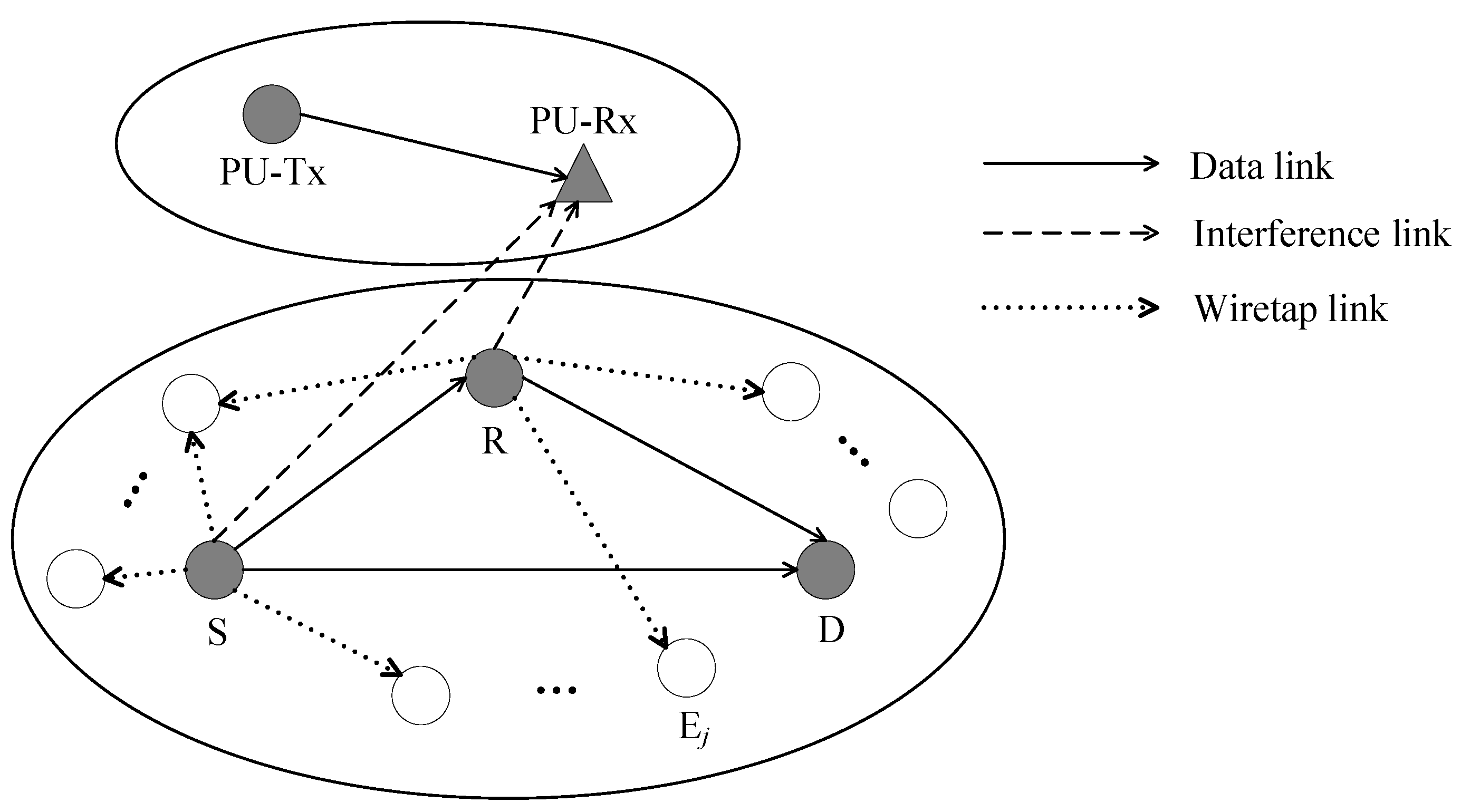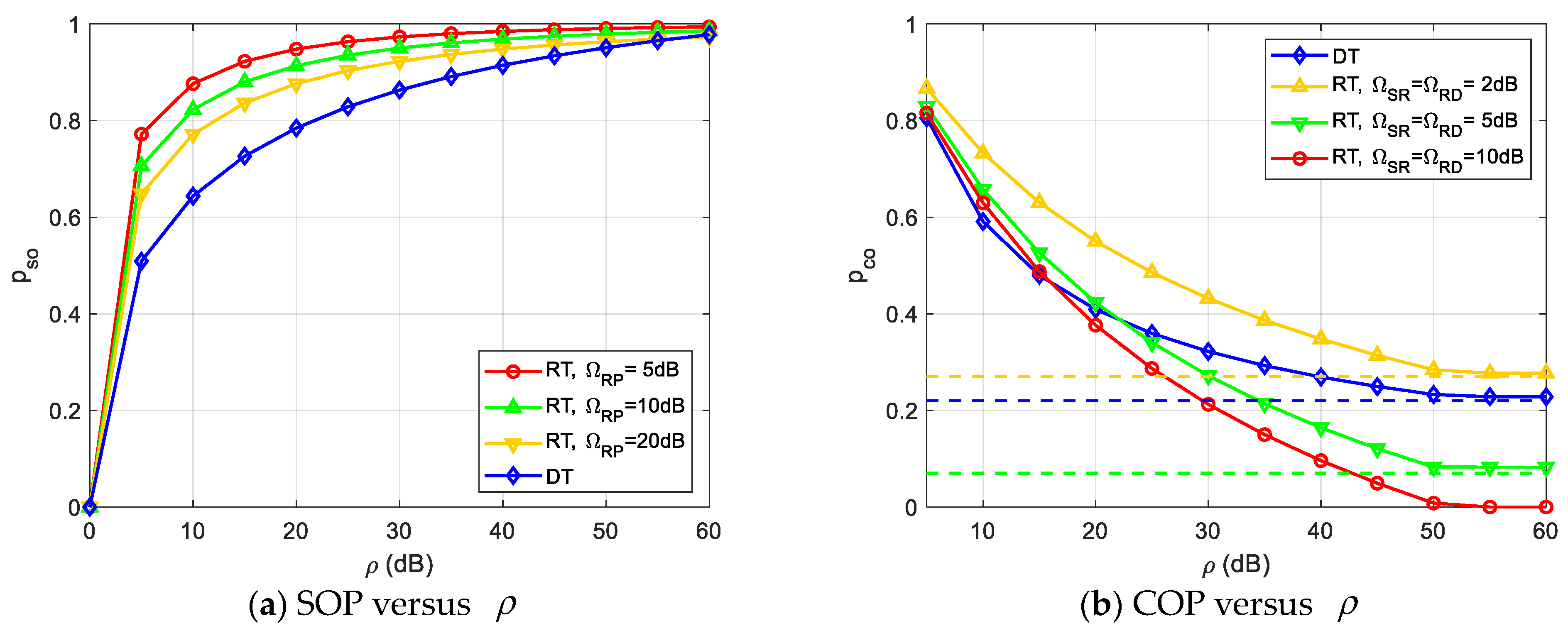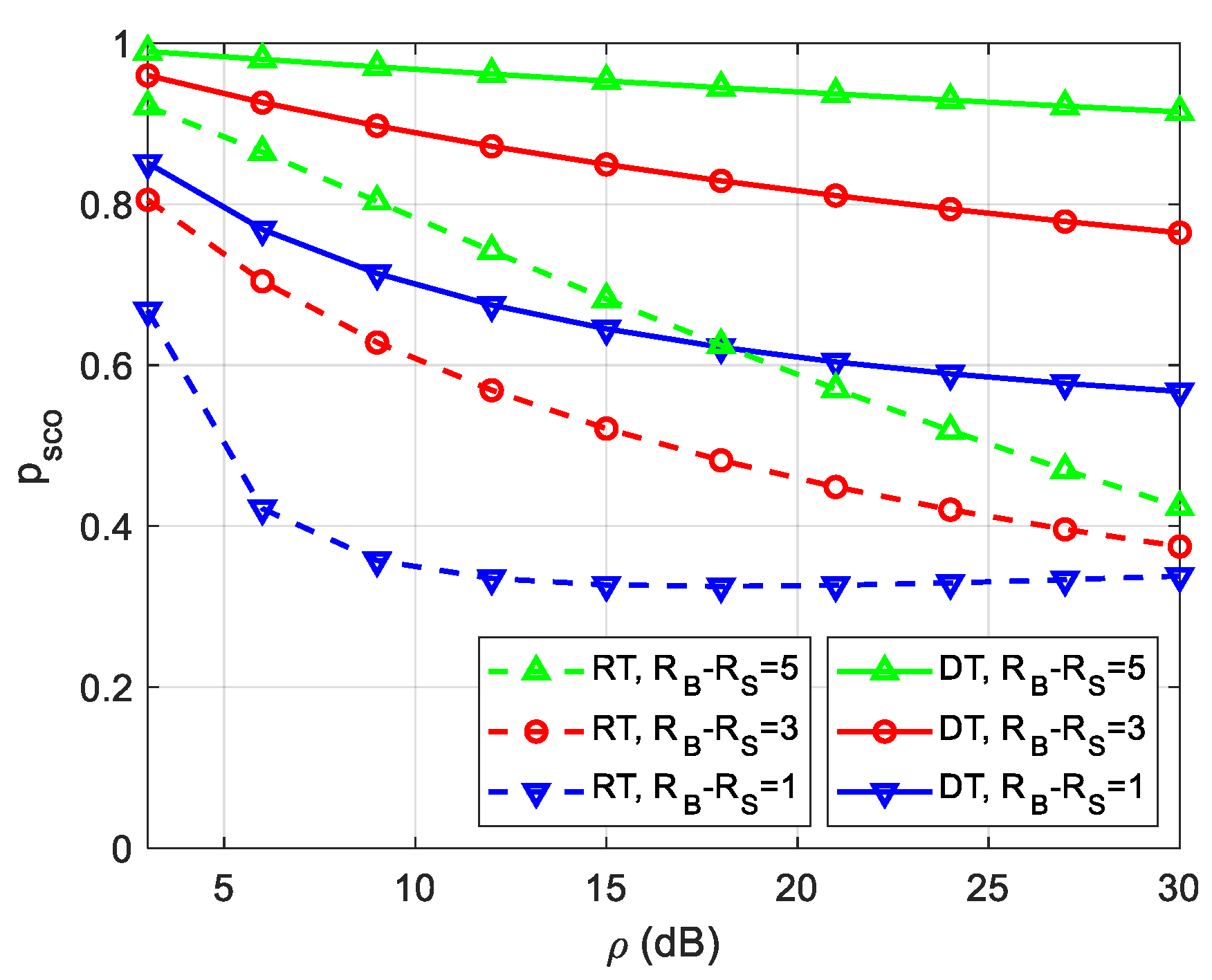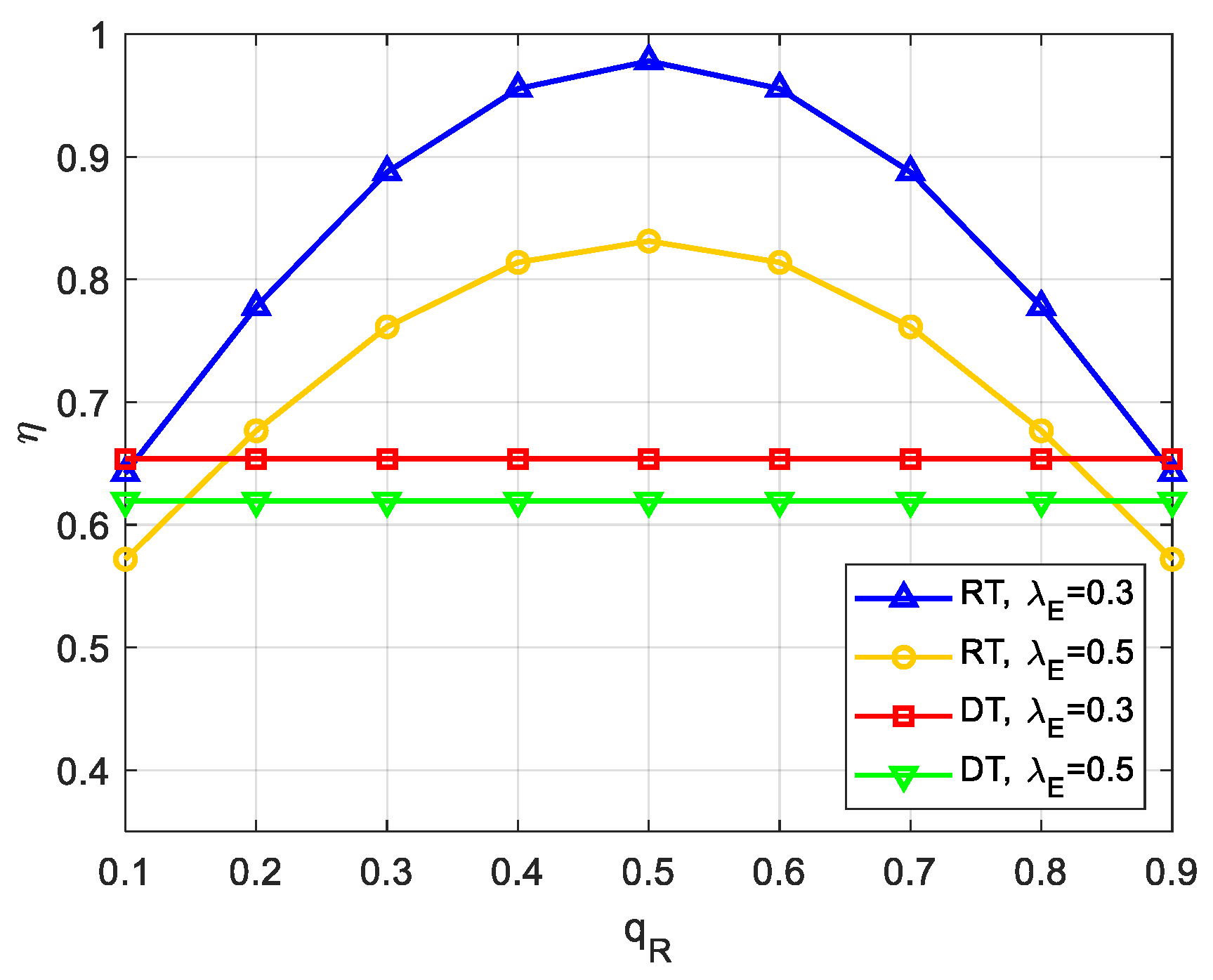Secrecy and Throughput Performance of Cooperative Cognitive Decode-and-Forward Relaying Vehicular Networks with Direct Links and Poisson Distributed Eavesdroppers
Abstract
1. Introduction
1.1. Background and Motivation
1.2. Related Work
- For simplicity, some ideal assumptions have always been made. For instance, many studies, such as [5,24,35,36], assumed that the direct link between SU-Tx and its receiver (SU-Rx) is unavailable because of the severe shadowing or path loss, and the direct link between SU-Tx and E is also neglected since E is far away from SU-Tx and outside the transmission range of the first hop. It is unrealistic because vehicles are moving, and the direct links can be available when the receiver (SU-Rx or E) moves close to SU-Tx and does not experience severe fading or shadowing. Also, direct links can affect both legitimate and wiretap transmissions [7], so the impact of direct links should not be ignored for secure transmission in such networks;
- In terms of wiretap channels, many papers [5,7,25] have focused on the perfect CSI or single eavesdropper, while there is always a potentially large number of passive eavesdroppers who deliberately conceal their CSI or location information from legitimate users in practical scenarios. Therefore, it is necessary to model the location set of eavesdroppers as a stochastic process following some distributions [37,38]. However, it has been rarely discussed for secrecy analysis in such networks.
- Most work has studied the PLS of cooperative cognitive vehicular networks in the AF relaying protocol, such as [5,7,23,24], but only a few studies have focused on the DF protocol, such as [39]. It is understandable because AF can provide lower latency and complexity, which is crucial for real-time IoV networks. However, meanwhile, AF worsens the legitimate channels because of its non-regenerative principle, where the relay directly amplifies and forwards the received signals without decoding, causing the accumulation of noise and a decrease in system performance. This is not conducive to communication data with high reliability requirements, such as passenger privacy, security information, etc. By comparison, DF is more suitable for some communication environments with relaxed latency but strict reliability requirements because it can eliminate the impact of fading on the first hop by decoding and regenerating the received signal [25,40]. Refs. [41,42,43] have also studied the gain between AF and DF; for instance, Ref. [41] concluded that from a diversity–multiplexing tradeoff (DMT) perspective, DF is strictly optimal over a certain range of the multiplexing gains, but the DMT of AF is offset by a constant term depending on the quality of CSI of the source-destination link only. Furthermore, Ref. [43] has proven that a hybrid decode–amplify–forward (HDAF) relaying protocol can achieve greater secure rate gain with the help of interfering nodes. Therefore, it is also necessary to study the applicability of DF in such networks.
1.3. Approach and Contributions
- Considering realistic traffic conditions, this paper establishes a more practical cognitive vehicular system model that not only considers secondary direct links and randomly distributed eavesdroppers but also adopts mixed Rayleigh and double-Rayleigh fading channels to characterize V2V and V2I links. Moreover, a DF relaying transmission scheme is proposed to provide theoretical supplements for existing AF works;
- According to the proposed system model, this paper derives the approximate expressions of the distribution functions of SNR for the traditional direct transmission scheme and the proposed relaying transmission scheme, respectively. We further deduce the closed-form expressions of the secrecy and throughput performance for each scheme and conduct an asymptotic analysis in the high SNR regime;
- Designing numerical simulations, this paper verifies our theoretical findings and discusses the performance comparison of the two schemes, the impact of network parameters on security and throughput performance, and the relationship between the maximum secrecy throughput and the optimal relay position in order to provide useful design insights for relay networks with security constraints.
2. System Model and Scheme Description
2.1. System and Channel Models
2.2. Transmission Scheme
3. Performance Analysis of the Direct Transmission Scheme
3.1. The PDFs and CDFs of SNR
3.2. Secrecy and Throughput Performance Analysis
- SOP represents the probability that a secrecy outage event happens when the secure transmission cannot be guaranteed, which is given by [52] as follows:where denotes the wiretap channel capacity. (15) can be rewritten as follows:substituting (13) into (16), SOP can be obtained as follows:
- COP represents the probability that a connection outage event happens when the message cannot be decoded at the intended receiver correctly, which can be expressed as follows:where denotes the wiretap channel capacity. (18) can be rewritten as follows:substituting (10) into (19), COP can be derived as follows:by using ([49], Equation (07.45.26.0005.01)), where is the Meijer-G function [49], (20) can be further expressed as follows:
- SCOP represents the probability that either the secrecy outage or the connection outage happens, which can comprehensively reflect the joint performance of security and reliability. SCOP can be given as:It is worth noting that the calculation of (22) is tedious and intractable due to the mutual correlation between security () and reliability (). We assume that the SOP and COP are independent, which is reasonable in CR networks with fixed transmit power [15], so (22) can be simplified as:substituting (17) and (20), SCOP can be derived as:
- Secrecy throughput quantifies the achievable average secrecy rate at which the message can be transmitted securely and reliably to D, which is given as:substituting (24), secrecy throughput can be finally obtained as:
4. Performance Analysis of the Relaying Transmission Scheme
4.1. The CDFs of SNR
4.2. Secrecy and Throughput Performance Analysis
- SOP: referring to (15), SOP can be expressed as:according to the different decoding situations of R and substituting (36) and (39), (40) expands as:where is the probability that R cannot decode the message correctly, i.e., the COP of R, which can be calculated by referring to (18):referring to the CDF of in (10), can be expressed as:Thus, the average SOP can be obtained by using the expectation formula .
- COP: referring to (18), COP can be expressed as:similarly, substituting (35) and (38), (44) expands as (45), and the average COP can be obtained by calculating its expectation.where , .
- SCOP: referring to (23), the average SCOP can be expressed as:
- Secrecy throughput: referring to (25) and the principle of the RT scheme, the average secrecy throughput is expressed according to the total probability theorem:
4.3. Asymptotic Analysis
5. Simulations
6. Conclusions
Author Contributions
Funding
Data Availability Statement
Acknowledgments
Conflicts of Interest
References
- Xu, L.; Huang, L.; Cao, C.; Wang, H.; Li, Y.; Gulliver, T.A. Outage performance of mobile V2V cooperative networks. Phys. Commun. 2019, 34, 295–300. [Google Scholar] [CrossRef]
- Li, S.; Wang, F.; Gaber, J.; Chang, X. Throughput and energy efficiency of cooperative ARQ strategies for VANETs based on hybrid vehicle communication mode. IEEE Access 2020, 8, 114287–114304. [Google Scholar] [CrossRef]
- Ngo, F.J.M.A. Performance analysis of cooperative V2V and V2I communications under correlated fading. IEEE Trans. Intell. Transp. 2020, 21, 3476–3484. [Google Scholar]
- Feng, J.; Yu, F.R.; Pei, Q.; Chu, X.; Du, J.; Zhu, L. Cooperative computation offloading and resource allocation for blockchain-enabled mobile-edge computing: A deep reinforcement learning approach. IEEE Int. Things J. 2020, 7, 6214–6228. [Google Scholar] [CrossRef]
- Suneel, Y.; Anshul, P. On the secrecy performance of cooperative cognitive vehicular relay networks. In Proceedings of the IEEE International Conference on Advanced Networks and Telecommunications Systems (ANTS), BITS Pilani, Goa, India, 16–19 December 2019. [Google Scholar]
- Cai, C.X.; Cai, Y.M.; Zhou, X.Y.; Yang, W.W.; Yang, W.D. When does relay transmission give a more secure connection in wireless Ad Hoc networks? IEEE. Trans. Inf. Foren. Sec. 2014, 9, 624–632. [Google Scholar] [CrossRef]
- Anshul, P.; Suneel, Y.; Dinh-Thuan, D.; Rupak, K. Secrecy performance of cooperative cognitive AF relaying networks with direct links over mixed Rayleigh and double-Rayleigh fading channels. IEEE Trans. Veh. Technol. 2020, 69, 15095–15112. [Google Scholar]
- Wyner, A.D. The wire-tap channel. Bell Labs. Tech. J. 1975, 54, 1355–1387. [Google Scholar] [CrossRef]
- Pan, G.F.; Tang, C.Q.; Zhang, X.; Li, T.T.; Weng, Y.; Chen, Y.F. Physical-layer security over non-small-scale fading channels. IEEE Trans. Veh. Technol. 2016, 65, 1326–1339. [Google Scholar] [CrossRef]
- Liu, Y.; Qin, Z.; Elkashlan, M.; Gao, Y.; Hanzo, L. Enhancing the physical layer security of non-orthogonal multiple access in large-scale networks. IEEE Trans. Wirel. Commun. 2017, 16, 1656–1672. [Google Scholar] [CrossRef]
- Fan, L.; Yang, N.; Duong, T. Exploiting direct links for physical layer security in multi-user multi-relay networks. IEEE Trans. Wirel. Commun. 2016, 15, 3856–3867. [Google Scholar] [CrossRef]
- Zhao, H.; Pan, G. Analysis of secure communications for a DF and RF relaying SIMO system with Gauss errors. Sci. Sin-Inf. 2016, 46, 350–360. [Google Scholar] [CrossRef]
- Sun, A.; Liang, T.; Li, B. Secrecy performance analysis of cognitive sensor radio networks with an EH-based eavesdropper. Sensors 2017, 17, 1026. [Google Scholar] [CrossRef]
- Li, J.; Zhao, H.; Johnson, M. Secrecy performance analysis of a cognitive network for IoT over k-μ channels. Wirel. Commun. Mob. Com. 2021, 6, 1–12. [Google Scholar] [CrossRef]
- Xu, X.M.; He, B.A.; Yang, W.W.; Zhou, X.Y.; Cai, Y.M. Secure transmission design for cognitive radio networks with Poisson distributed eavesdroppers. IEEE. Trans. Inf. Foren. Sec. 2016, 11, 373–387. [Google Scholar] [CrossRef]
- Chopra, K.; Bose, R.; Joshi, A. Secrecy performance of threshold-based decode-and-forward cooperative cognitive radio network. IET Commun. 2017, 11, 1396–1406. [Google Scholar] [CrossRef]
- Mounia, B.; Faissal, E.B.; Mohamed-Slim, A. A PHY layer security analysis of uplink cooperative jamming-based underlay CRNs with multi-eavesdroppers. IEEE Trans. Cogn. Commun. 2020, 6, 704–717. [Google Scholar]
- Zhang, T.; Cai, Y.M.; Huang, Y.Z.; Duong, T.Q.; Yang, W.W. Secure transmission in cognitive MIMO Relaying networks with outdated channel state information. IEEE Access 2016, 4, 8212–8224. [Google Scholar] [CrossRef]
- Yang, Q.Q.; Ding, J.; Hu, A.G. Secrecy outage performance analysis of DF cognitive relay network with co-channel interference. Wirel. Pers. Commun. 2019, 107, 549–564. [Google Scholar] [CrossRef]
- Zhang, J.; Pan, X.; Zhuang, Y. Secrecy performance for underlay cognitive multi-relaying MISO-RF/SIMO-FSO networks with outdated CSI. Phys. Commun. 2021, 48, 1–12. [Google Scholar] [CrossRef]
- Salo, J.; El-Sallabi, H.M.; Vainikainen, P. Statistical analysis of the multiple scattering radio channel. IEEE Trans. Antenn. Propag. 2006, 54, 3114–3124. [Google Scholar] [CrossRef]
- Nguyen, S.Q.; Kong, H.Y. Outage probability analysis in dual-hop vehicular networks with the assistance of multiple access points and vehicle nodes. Wirel. Pers. Commun. 2016, 87, 1175–1190. [Google Scholar] [CrossRef]
- Pandey, A.; Yadav, S. Physical layer security in cooperative AF relaying networks with direct links over mixed Rayleigh and double-Rayleigh fading channels. IET Commun. 2018, 67, 10615–10630. [Google Scholar] [CrossRef]
- Pandey, A.; Yadav, S. Physical layer security in cooperative amplify-and-forward relay networks over mixed Nakagami-m and double Nakagami-m fading channels: Performance evaluation and optimization. IET Commun. 2020, 14, 95–104. [Google Scholar] [CrossRef]
- Mohamed, G.A.; Ahmed, H.A.; Mohammed, A. Secrecy performance and power allocation for cooperative vehicular relaying networks in the presence of interference. In Proceedings of the International Conference on Computing, Networking and Communications (ICNC), Honolulu, HI, USA, 20–22 February 2023. [Google Scholar]
- Serdar, Z.A.; Erdogan, E. Secrecy outage probability of inter-vehicular cognitive radio networks. Int. J. Commun. Syst. 2020, 33, 1–11. [Google Scholar]
- Hu, C.; Li, Q.; Yang, L.; Qin, J. Joint power allocation and collaborative beamforming for physical layer security in underlay CR NOMA relay systems. Phys. Commun. 2021, 48, 1–11. [Google Scholar] [CrossRef]
- Li, Q.; Yang, Y.; Ma, W.K.; Lin, M.; Ge, J.; Lin, J. Robust cooperative beamforming and artificial noise design for physical-layer secrecy in AF multi-antenna multi-relay networks. IEEE Trans. Signal. Proces. 2014, 63, 206–220. [Google Scholar] [CrossRef]
- Mensi, N.; Rawat, D.B.; Balti, E. PLS for V2I communications using friendly jammer and double kappa-mu shadowed fading. In Proceedings of the IEEE International Conference on Communications (ICC), Montreal, QC, Canada, 14–23 June 2021. [Google Scholar]
- Xie, P.; Zhang, J.; Xing, M.; Zhang, L.; Wu, G. Aided opportunistic jammer selection for secrecy improvement in underlay cognitive radio networks. Wirel. Pers. Commun. 2019, 107, 1–20. [Google Scholar] [CrossRef]
- Ghadi, F.R.; Kaveh, M.; Martín, D. Performance analysis of RIS/STAR-IOS-aided V2V NOMA/OMA communications over composite fading channels. arXiv 2023, arXiv:2309.07738. [Google Scholar] [CrossRef]
- Yang, L.; Yang, J.; Xie, W.; Hasna, M.O.; Tsiftsis, T.; Di Renzo, M. Secrecy performance analysis of RIS-aided wireless communication systems. IEEE Trans. Veh. Technol. 2020, 69, 12296–12300. [Google Scholar] [CrossRef]
- Kaveh, M.; Yan, Z.; Jäntti, R. Secrecy performance analysis of RIS-aided smart grid communications. IEEE Trans. Industr. Inform. 2023, 1–13. [Google Scholar] [CrossRef]
- Wei, L.; Wang, K.; Pan, C.; Elkashlan, M. Secrecy performance analysis of RIS-aided communication system with randomly flying eavesdroppers. IEEE Wireless Commun. Lett. 2022, 11, 2240–2244. [Google Scholar] [CrossRef]
- Saad, W.; Shokair, M.; Ibraheem, S.M. On the security of relay assisted cognitive radio networks in the presence of primary transceiver network. Wirel. Pers. Commun. 2019, 104, 949–977. [Google Scholar] [CrossRef]
- Zhao, R.; Yuan, Y.; Fan, L.; He, Y. Secrecy performance analysis of cognitive decode-and-forward relay networks in Nakagami-m fading channels. IEEE Trans. Commun. 2017, 65, 549–563. [Google Scholar] [CrossRef]
- Pinto, P.C.; Barros, J.; Win, M.Z. Secure communication in stochastic wireless networks—Part I: Connectivity. IEEE Trans. Inf. Foren. Sec. 2012, 7, 125–138. [Google Scholar] [CrossRef]
- Pinto, P.C.; Barros, J.; Win, M.Z. Secure communication in stochastic wireless networks—Part II: Maximum rate and collusion. IEEE Trans. Inf. Foren. Sec. 2012, 7, 139–147. [Google Scholar] [CrossRef]
- Ji, B.; Han, Y.; Li, P. Research on secure transmission performance of electric vehicles under Nakagami-m channel. IEEE Trans. Intell. Transp. Syst. 2020, 22, 1881–1891. [Google Scholar] [CrossRef]
- Zhang, J.; Pan, G. Secrecy outage analysis with Kth best relay selection in dual-hop inter-vehicle communication systems. Int. J. Electron. Commun. 2017, 71, 139–144. [Google Scholar] [CrossRef]
- Kim, T.T.; Poor, H.V. On the diversity gain of AF and DF relaying with noisy CSI at the source transmitter. IEEE Trans. Inf. Theory 2009, 55, 5064–5073. [Google Scholar] [CrossRef]
- Lai, L.; Gamal, H.E. The relay–eavesdropper channel: Cooperation for secrecy. IEEE Trans. Inf. Theory 2008, 54, 4005–4019. [Google Scholar] [CrossRef]
- Gurrala, K.K.; Das, S. Performance study of hybrid decode–amplify–forward (HDAF) relaying scheme for physical layer security in wireless cooperative network. Int. J. Commun. Syst. 2017, 30, e3182. [Google Scholar] [CrossRef]
- Li, Z.; Jia, L.; Li, F. Outage performance analysis in relay-assisted inter-vehicular communications over double-Rayleigh fading channels. IEEE Int. Conf. Commun. Mobile Comput. 2010, 2, 266–270. [Google Scholar]
- Nguyen, B.C.; Hoang, T.M.; Dung, L.T. Performance analysis of vehicle-to-vehicle communication with full-duplex amplify-and-forward relay over double-Rayleigh fading channels. Veh. Commun. 2019, 19, 100166. [Google Scholar] [CrossRef]
- Sklar, B. Rayleigh fading channels in mobile digital communication systems. I. Characterization. IEEE Commun. Mag. 1997, 35, 90–100. [Google Scholar] [CrossRef]
- Islam, M.R.; Hamouda, W. Performance of cooperative ad-hoc networks in Rayleigh fading channels. In Proceedings of the IEEE Vehicular Technology Conference, Montreal, QC, Canada, 25–28 September 2006; pp. 1–4. [Google Scholar]
- Prudnikov, A.P.; Brychkov, Y.A.; Marichev, O.I. Integrals and Series. Volume 2: Special Functions; Gordon and Breach Science Publishers: Philadelphia, PA, USA, 1992. [Google Scholar]
- The Wolfram Functions Site. Available online: http://functions.wolfram.com/ (accessed on 14 February 2024).
- Gradshteyn, I.S.; Ryzhik, I.M. Table of Integrals, Series, and Products, 6th ed.; Academic Press: New York, NY, USA, 2000. [Google Scholar]
- Bloch, M.; Barros, J.; Rodrigues, M.R.D.; McLaughlin, S.W. Wireless information-theoretic security. IEEE Trans. Inf. Theory 2008, 54, 2515–2534. [Google Scholar] [CrossRef]
- He, B.; Zhou, X. Secure on-off transmission design with channel estimation errors. IEEE Trans. Inf. Foren. Sec. 2013, 8, 1923–1936. [Google Scholar] [CrossRef]
- Papoulis, A.; Pillai, S.U. Probability, Random Variables, and Stochastic Processes, 4th ed.; McGraw-Hill Book Co.: New York, NY, USA, 2001. [Google Scholar]








| Context | This Work | [5] | [7] | [17] | [24] | [39] |
|---|---|---|---|---|---|---|
| Cooperative Cognitive Vehicular Networks | Yes | Yes | Yes | No | No | Yes |
| Relaying Protocol | DF | AF | AF | DF | DF | DF |
| Direct link SU-Tx and SU-Rx | Yes | No | Yes | No | No | No |
| Direct link SU-Tx and E | Yes | No | Yes | Yes | No | No |
| Performance Analysis | PLS, Throughput | PLS | PLS | PLS | PLS | PLS |
| Eavesdropping Nodes | Multiple | Single | Single | Multiple | Single | Multiple |
| Fading Scenario | Rayleigh and Double- Rayleigh | Rayleigh and Double- Rayleigh | Rayleigh and Double-Rayleigh | Nakagami-m | Nakagami-m and Double Nakagami-m | Nakagami-m |
| First Time Slot | Second Time Slot | |
|---|---|---|
| S → PU-Rx (Interference) | (only when D decodes with error) | |
| S → R and D (Data) | If R has decoded correctly | R → PU-Rx (Interference) R → D (Data) R → E (Wiretap) |
| S → E (Wiretap) | If R has decoded incorrectly | S → PU-Rx (Interference) S → D (Data) S → E (Wiretap) |
Disclaimer/Publisher’s Note: The statements, opinions and data contained in all publications are solely those of the individual author(s) and contributor(s) and not of MDPI and/or the editor(s). MDPI and/or the editor(s) disclaim responsibility for any injury to people or property resulting from any ideas, methods, instructions or products referred to in the content. |
© 2024 by the authors. Licensee MDPI, Basel, Switzerland. This article is an open access article distributed under the terms and conditions of the Creative Commons Attribution (CC BY) license (https://creativecommons.org/licenses/by/4.0/).
Share and Cite
Wang, F.; Li, C.; Xie, J.; Su, L.; Liu, Y.; Du, S. Secrecy and Throughput Performance of Cooperative Cognitive Decode-and-Forward Relaying Vehicular Networks with Direct Links and Poisson Distributed Eavesdroppers. Electronics 2024, 13, 777. https://doi.org/10.3390/electronics13040777
Wang F, Li C, Xie J, Su L, Liu Y, Du S. Secrecy and Throughput Performance of Cooperative Cognitive Decode-and-Forward Relaying Vehicular Networks with Direct Links and Poisson Distributed Eavesdroppers. Electronics. 2024; 13(4):777. https://doi.org/10.3390/electronics13040777
Chicago/Turabian StyleWang, Fan, Cuiran Li, Jianli Xie, Lin Su, Yadan Liu, and Shaoyi Du. 2024. "Secrecy and Throughput Performance of Cooperative Cognitive Decode-and-Forward Relaying Vehicular Networks with Direct Links and Poisson Distributed Eavesdroppers" Electronics 13, no. 4: 777. https://doi.org/10.3390/electronics13040777
APA StyleWang, F., Li, C., Xie, J., Su, L., Liu, Y., & Du, S. (2024). Secrecy and Throughput Performance of Cooperative Cognitive Decode-and-Forward Relaying Vehicular Networks with Direct Links and Poisson Distributed Eavesdroppers. Electronics, 13(4), 777. https://doi.org/10.3390/electronics13040777






